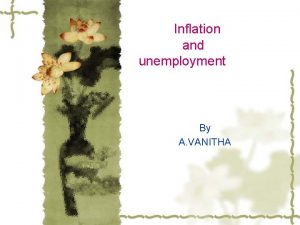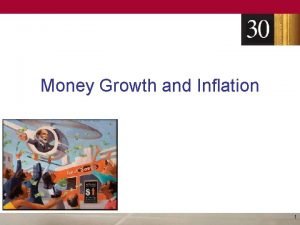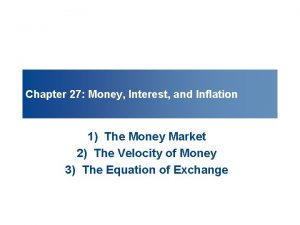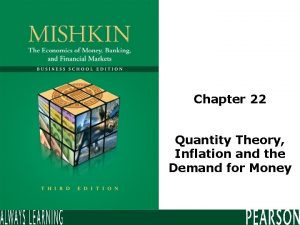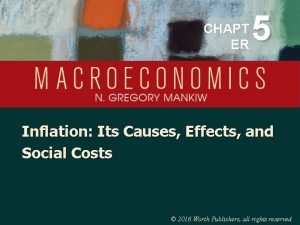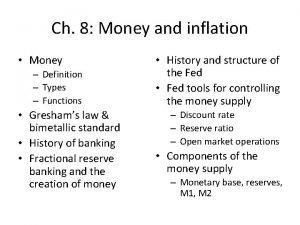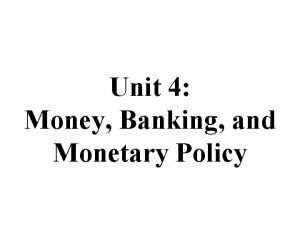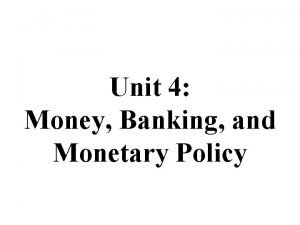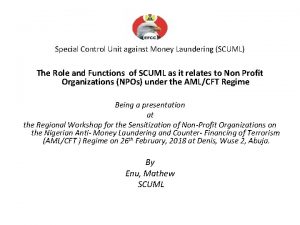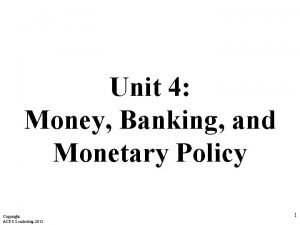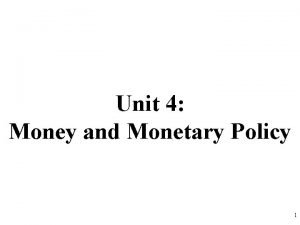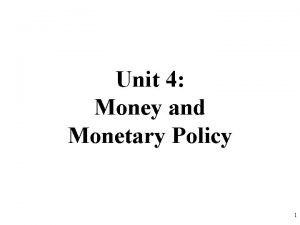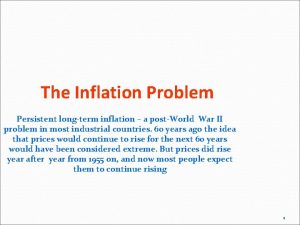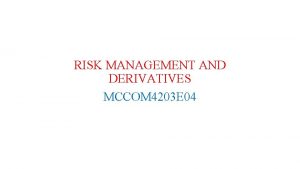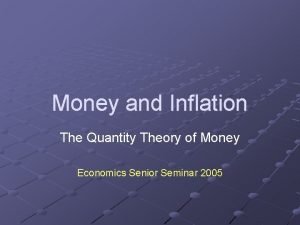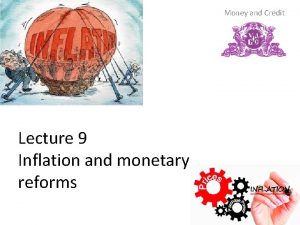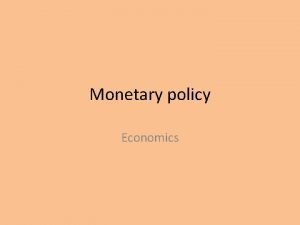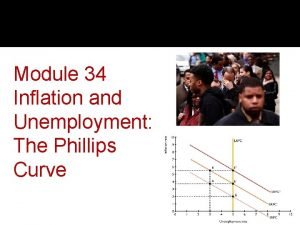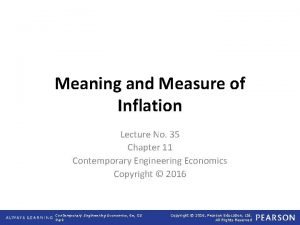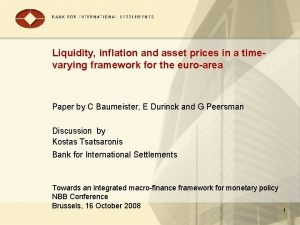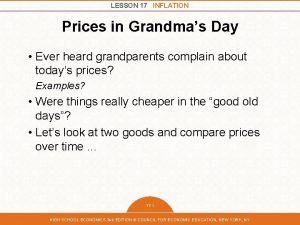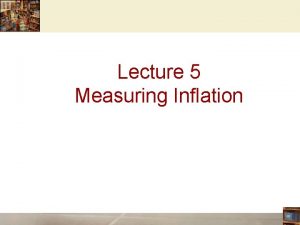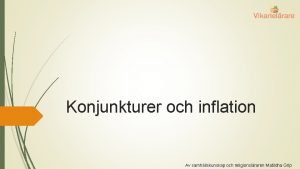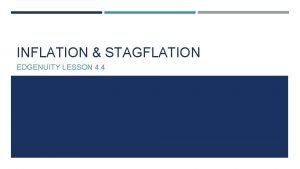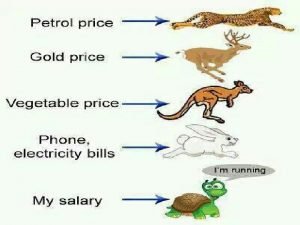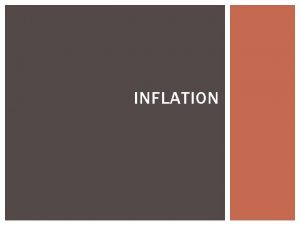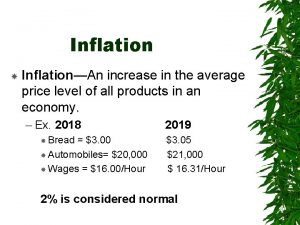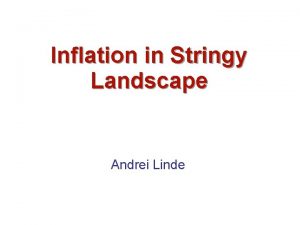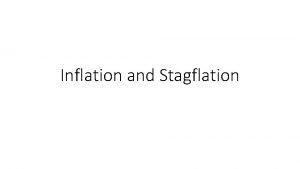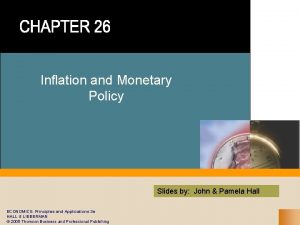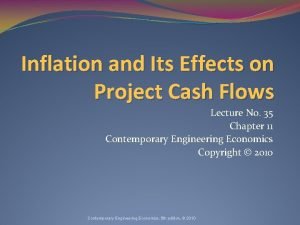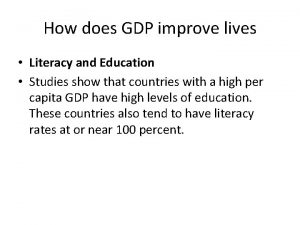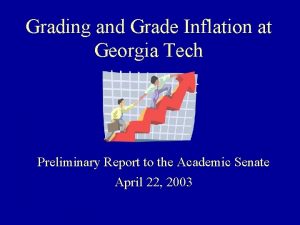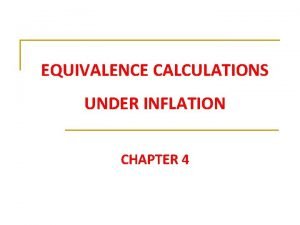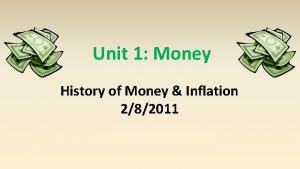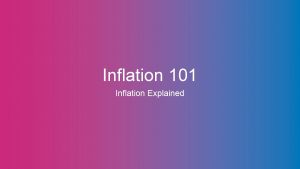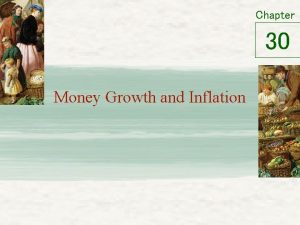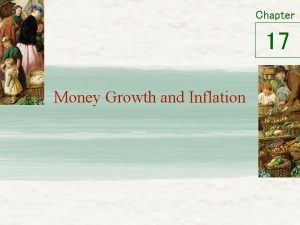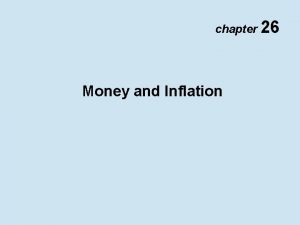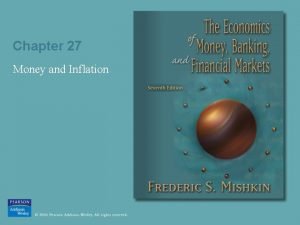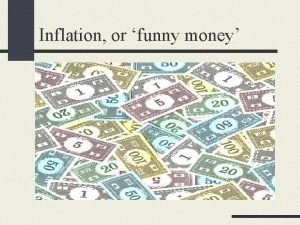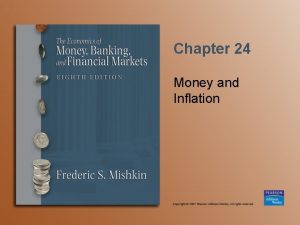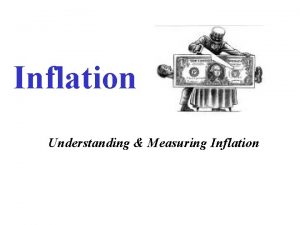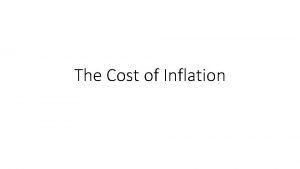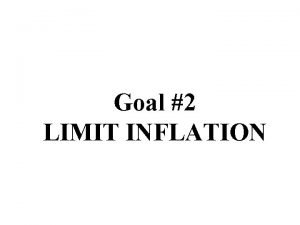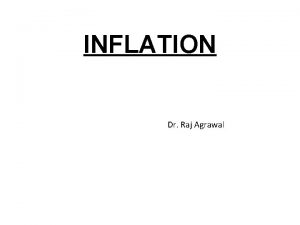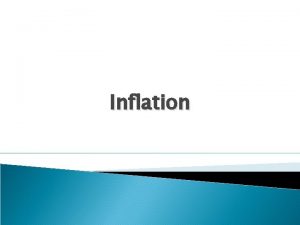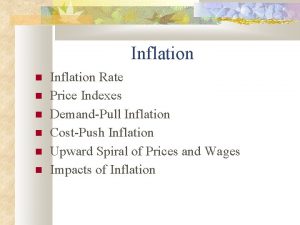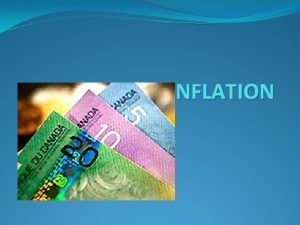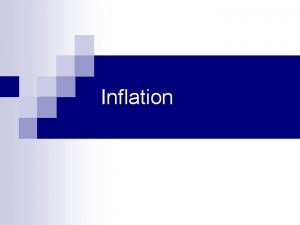Unit 1 Money History of Money Inflation 282011





















































- Slides: 53

Unit 1: Money History of Money & Inflation 2/8/2011

Inflation inflation – a rise in the price level (fall in PPM) hyperinflation – a rise in the price level exceeding 50% per month

History Through most of history, war and inflation were closely related. Most government spending was on war before the modern welfare state.

History Denarius silver debasement in the Roman empire 54 AD 218 AD 268 AD 94% silver content 43% silver content 1% silver content Rise in the price level results from the increase in the money stock, not from the fall in value of the coin. In contrast, Athens drakma never debased.

History

History The classical gold standard experienced a gradual deflation of 0. 5% per year on average. Countries would temporarily leave the gold standard to inflate for war, and return afterward – often at the old level.

History During the 16 th century, Spain’s price level increased 200 -300% due to gold and silver imports from the new world (1% per year). 185, 000 kg of gold was imported in 15 years, increasing Europe’s gold supply by 20%.

History Colonial Americans generally used Spanish dollar coins rather than British pounds because England had a prohibition on the export of specie to the colonies. Often the unit of account was pounds, but the medium of exchange was dollars.

History Revolutionary War financing 6% taxation 19% borrowing 75% seigniorage continentals 226 million issued by Congress 200 million issued by states counterfeit by British

History “not worth a continental” – totally without value continentals : pounds 1775 3 to 1 1778 5 to 1 1779 30 to 1 1780 76 to 1 1781 167 to 1 later totally worthless

History In the west, American colonies were first to use paper money. This was one of the first hyperinflations in history. Continentals were totally repudiated, but debt was paid back. Congress didn’t accept own currency in March of 1781.

History Civil War financing (North) 20% taxation 65% borrowing 15% seigniorage Civil War financing (South) 7% taxation 24% borrowing 52% seigniorage 17% seizing supplies

History confederate dollar in specie 1862 82. 7¢ 1863 29. 0¢ 1865 1. 7¢ later totally worthless Price level increase North 90. 5%↑ South 2076%↑

History 20 th century America The purchasing power of the dollar has declined 95. 5% since 1913 when the Federal Reserve was created.

History German hyperinflation 1921 -1923, the Weimar Republic (Germany) was unable to afford its WWI reparation payments required under the Treaty of Versailles (132 billion goldmarks – far more than the total German gold).

History Price of a pound of butter 1914 1. 4 marks 1918 3 marks 1922 2400 marks 1923 6 trillion marks

History There were no wage and price controls this crisis. Germans didn’t revert to barter (shows transactions costs). Germans didn’t revert to foreign money (shows network effects). Hyperinflation ended with a currency reform: cut 12 zeros.

History In post WWII Germany there was fear of inflation, so wage and price controls were imposed. This led to rationing, black markets, and reversion to barter. Ludwig Gerhart eliminated all wage and price controls on a Sunday, which began the German miracle (real wages doubled).

History Reversion to barter means the monetary system completely broke down. The lesson is clear: It is better to have hyperinflation with no wage and price controls than wage and price controls with no hyperinflation.

History Zimbabwe’s inflation began shortly after it repudiated debt owed to the International Monetary Fund and confiscated all white-owned farmland.

History Zimbabwe inflation rate 2004 132. 75% 2005 585. 84% 2006 1, 281. 11% 2007 66, 212. 3% 2008 231, 150, 888. 87% 2009 6. 5 x 10108%* * 6. 5 quindecillion novemdecillion percent (650 million googol)

Hyperinflations • • • • Angola 1991 -1995 Argentina 1975 -1991 Austria 1921 -1922 Belarus 1994 -2002 Bolivia 1984 -1986 Bosnia 1992 -1993 Brazil 1986 -1994 Bulgaria 1996 Chile 1971 -1973 China 1948 -1949 Danzig 1922 -1923 Georgia 1993 -1995 Germany 1922 -1923 Greece 1942 -1944 • • • • Hungary 1945 -1946 Israel 1970 -1971 Japan 1948 -1951 Krajina 1992 -1993 Madagascar 2004 -2005 Mozambique 1977 -1992 Nicaragua 1987 -1990 Peru 1988 -1990 Philippines 1942 -1944 Poland 1989 -1991 Romania 1998 -2005 Russia 1921 -1922 Russia 1992 -1999 Turkey 1990 -1995 • • • Ukraine 1993 -1995 United States 1861 -1865 Yugoslavia 1989 -1994 Zaire 1989 -1996 Zimbabwe 2004 -2010

Gresham’s Law – an artificially overvalued money tends to drive an artificially undervalued money out of circulation Sometimes inaccurately stated as “bad money drives out good. ” Applies when government sets exchange rates between monies.

Gresham’s Law applies to new coins and worn coins. Worn coins are likely to have lost some of their metallic weight through wear and tear, so they should have less value than new coins. But government sets them to have the same value. Thus worn coins are artificially overvalued and new coins are artificially undervalued.

Gresham’s Law Merchants want to hoard the coins with full metal content and pass along coins with less metal content. So worn coins tend to stay in circulation and new coins are drawn out of circulation when commodity money is used. The artificially overvalued money drives the artificially undervalued money out of circulation – bad money drives out good.

Gresham’s Law Worn coins & new coins New coins undervalued Worn coins overvalued Therefore, Worn coins drive out new coins

Gresham’s Law parallel standard – market exchange rate with two monies bimetallic standard – government fixed exchange rate of gold and silver

Gresham’s Law Silver to gold ratio 1792 (Hamilton) Fixed: 15 to 1 Market: 15. 5 to 1 Gold undervalued Silver overvalued Therefore, Silver drives out gold

Gresham’s Law Silver to gold ratio 1835 Fixed: 16 to 1 Market: 15. 5 to 1 Gold overvalued Silver undervalued Therefore, Gold drives out silver

Gresham’s Law Silver to gold ratio 1866 Fixed: 16 to 1 Market: 30 to 1 Gold undervalued Silver overvalued Therefore, Silver should drive out gold … but silver was de-monetized

Gresham’s Law Silver was good for small transactions and gold was good for large transactions. In the absence of government interference, both would circulate. Most countries were on bimetallic standards, but went to gold standard by default through Gresham’s Law.

Inflation “Inflation is always and everywhere a monetary phenomenon. ” – Milton Friedman Inflation used to be synonymous with monetary growth. Now it means a rise in the price level.

Inflation • high money growth o can cause persistent high inflation o there is no limit to money growth • fiscal policy alone o cannot cause persistent high inflation o spending limited to 100% of GDP, polit. pressures • supply-side phenomena o cannot cause persistent high inflation o price level rises temporarily, then reverts to old level

Seigniorage seigniorage – profit that results from producing coins (difference between face value and metal value)

Seigniorage government revenue • taxation • borrowing • seigniorage

Seigniorage Governments that find it hard to borrow or tax must rely more on seigniorage. Therefore, poorer countries tend to have higher rates of seigniorage – and thus higher inflation.

Seigniorage debasement – lowering the value of the currency (usually commodity money)

Seigniorage M = PQ + C + S M ≡ nominal value assigned to coin P ≡ nominal price paid per oz. of precious metal Q ≡ number of oz. of precious metal in the coin C ≡ cost of coining the metal (“brassage”) S ≡ nominal seigniorage

Seigniorage M = PQ + C + S Competition • price of a coin (M) equals marginal cost of a coin (PQ + C) • M = PQ + C means S = 0 • with informed coin users, Q adheres to a quality standard (below standard coins rejected or discounted) • competition bids up P until S = 0 at the margin

Seigniorage M = PQ + C + S Government (Royal Mint) • can earn seigniorage profit permanently • only if has legally protected monopoly • allows it to maintain P or Q below competitive level without losing business

Seigniorage M = PQ + C + S Debasement • reduces Q for given M • replace silver with cheaper “base” metal (copper, zinc, tin) • each coin is cheaper (C↑, but less than (PQ)↓) • debasement allows more coins per oz. of silver

Seigniorage M = PQ + C + S Debasement requires deceit or compusion • no seigniorage if public notices & discounts debased coins • short run: disguise debasement o mints use same dies, new coins nearly identical • long run: use legal tender laws to compel use o triggers Gresham’s law, can make calling in old coins compulsory, can increase P slightly above legal tender

Seigniorage M = PQ + C + S Seigniorage without debasement • reduce P instead of Q • draw metal to mint through compulsion • give mint monopsony privilege (all silver mines must sell to mint) • e. g. , all Spanish New World silver had to be sold to the Royal Spanish Mint at its price

Seigniorage M = PQ + C + S Fiat seigniorage • bullion content (Q) is zero • production cost (C) is near zero (6¢/note) • M = PQ + C + S reduces to M = S • nominal seigniorage equals approximately $100 for each $100 produced

Seigniorage M=S easier notation: S = ΔH s = S/P s = ΔH/P S ≡ nominal seigniorage s ≡ real seigniorage H ≡ high powered money (monetary base)

Seigniorage Laffer curve There exists a tax rate that will yield maximum government revenue. That rate is less than 100% because at higher tax rates the tax base shrinks: people are incentivized to work less and to evade taxes.

Seigniorage Bailey curve There exists a rate of monetary expansion that will yield maximum government seigniorage revenue. That rate is less than infinite because at higher expansion rates the demand for money falls: price level rises faster than nominal seigniorage.

Seigniorage s = ΔH/P s = (ΔH/H)(H/P) s = Eh E = ΔH/H h = H/P E ≡ growth rate of H (“tax rate”) h ≡ real money stock (“tax base”)

Seigniorage Bailey curve s* = E*h SRS curve maps perfect foresight rays (lines) from the origin show expectations

Seigniorage Bailey curve When target seigniorage (s^) is less than maximum seigniorage (s*), the Bailey curve converges to a steady state solution.

Seigniorage Bailey curve When target seigniorage (s^) is greater than maximum seigniorage (s*), the Bailey curve expands indefinitely. This is hyperinflation.

Seigniorage

Seigniorage
 Futa inflation meaning
Futa inflation meaning Dana damian
Dana damian Quantity theory of money inflation
Quantity theory of money inflation Economics velocity formula
Economics velocity formula Money market inflation
Money market inflation Quantity theory of money inflation
Quantity theory of money inflation Quantity theory of money inflation
Quantity theory of money inflation 8 money types
8 money types Quantity theory of money equation
Quantity theory of money equation Unit 10, unit 10 review tests, unit 10 general test
Unit 10, unit 10 review tests, unit 10 general test Gatsby physical description
Gatsby physical description Money smart money match
Money smart money match Money on money multiple
Money on money multiple Context of the great gatsby
Context of the great gatsby Old money vs new money
Old money vs new money There are photos from your photo album впр
There are photos from your photo album впр Also history physical
Also history physical Unit 4 money banking and monetary policy
Unit 4 money banking and monetary policy Unit 4 money banking and monetary policy
Unit 4 money banking and monetary policy Scuml exemption certificate
Scuml exemption certificate Unit 4 money and monetary policy
Unit 4 money and monetary policy Unit 4 money and monetary policy
Unit 4 money and monetary policy Unit 4 money and monetary policy
Unit 4 money and monetary policy Money advice unit stevenage
Money advice unit stevenage Fiscal policy to control inflation
Fiscal policy to control inflation Calculate inflation rate
Calculate inflation rate Shifters of lrpc
Shifters of lrpc Shoe leather costs
Shoe leather costs Inflation risk example
Inflation risk example Types of inflation
Types of inflation Hungary inflation rate 1946
Hungary inflation rate 1946 Consequences of inflation
Consequences of inflation Understanding inflation
Understanding inflation Short run phillips curve
Short run phillips curve Inflation formula
Inflation formula Inflation for dummies
Inflation for dummies Lesson 17 inflation activity 17.2 answers
Lesson 17 inflation activity 17.2 answers Inflation rate formula
Inflation rate formula Too much money is chasing too few goods
Too much money is chasing too few goods Ypically, high inflation is a sign of
Ypically, high inflation is a sign of Monga definition
Monga definition How is inflation measured
How is inflation measured How to measure inflation
How to measure inflation Two types of inflation
Two types of inflation Demand-pull inflation occurs when
Demand-pull inflation occurs when Cost push inflation
Cost push inflation Stagflation definition
Stagflation definition Built in inflation
Built in inflation Inflation rate formula
Inflation rate formula Stagflation occurs when high inflation combines with
Stagflation occurs when high inflation combines with Inflation definition
Inflation definition Georgia tech grade inflation
Georgia tech grade inflation Fiscal policy definition
Fiscal policy definition Rate of inflation formula
Rate of inflation formula
